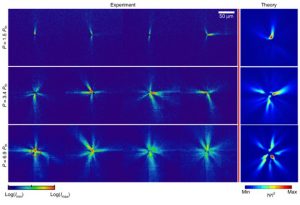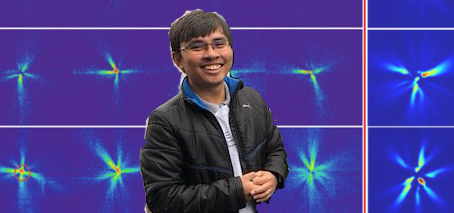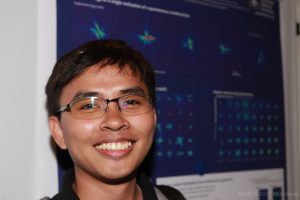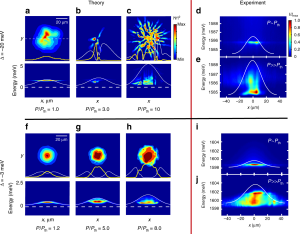- First snapshot of exciton-polariton Bose-Einstein condensation (BEC) in an inorganic semiconductor
- Unique opportunity to understand details of BEC without statistical averaging
- Key to fundamental understanding of exciton-polaritons
An ANU advance provides never-before-achieved ‘snapshot’ of Bose-Einstein condensation.
Previously, observations of exciton-polaritons in a Bose-Einstein condensate were limited to statistical averaging over millions of condensation events.
‘Snapshot’ imaging of polaritons forming a condensate in a typical inorganic semiconductor was considered impossible.
Now, FLEET researchers at the Australian National University have led an international study imaging exciton-polaritons for the first time as a ‘single shot’, rather than averaging.
“This offers a unique opportunity to understand the details of Bose-Einstein condensation of exciton-polaritons” explains lead author Eliezer Estrecho.
Such fundamental advances also aid FLEET’s research on excitonic condensation and superfluidity as a mechanism for electronic conduction without wasted dissipation of energy.

Exciton polariton: a hybrid particle composed of a photon (light) and an exciton (a bound electron-hole pair)
Exciton–polaritons are hybrid particles that are part-matter and part-light, bound together by strong coupling of photons and electron-hole pairs (excitons) within semiconductor microcavities, where they can form a Bose-Einstein condensate.
A Bose-Einstein condensate (BEC) is a quantum state of matter in which all particles have the same energy and wavelength, meaning that quantum effects can be seen on a macroscopic scale. A BEC can form a superfluid, i.e. flow without resistance.
However because exciton-polariton lifetime is measured in picoseconds (trillionths of a second), observations of BECs have previously always included averaging over million lifetimes of exciton-polaritons.
This is like taking a long exposure of moving objects—you get a blurred image.
The ANU team made sure that their sensitive camera captures only one lifetime or ‘single-shot’ of the condensate, enabling them to observe never-before-seen behaviour of exciton-polaritons.
The study
The single-shot imaging is performed by analysing coherent cavity photoluminescence due to the decay of exciton-polaritons. “Before now,” says Associate Prof. Elena Ostrovskaya, “this was thought to be impossible in inorganic microcavities, because emissions simply weren’t bright enough.”
The density of exciton-polaritons trapped in inorganic microcavities is too low to be detected in single-shot mode partly because the exciton-polariton doesn’t live long enough for the density to build up.
To get a better signal, the team used ultra-high quality samples designed and made by their collaborators in the USA, extending the lifetime of polaritons by an order of magnitude and pushing the density high enough for the sensitive camera to detect.
The imaging revealed that contrary to the smooth condensate observed in averaged experiments, the condensate actually forms filaments (see image below) whose orientation varies from shot-to-shot.
This filamentation is a result of polariton interaction with an incoherent reservoir, and is an intrinsic property of non-equilibrium condensation.
This feature is especially pronounced for exciton-polaritons with photon-like character and is less evident for exciton-polaritons with exciton-like behaviour, which are closer to equilibrium.
The study found remarkable agreement between experiment and numerical simulations, validating the background theory of exciton-polariton condensate dynamics.

Single-shot condensation of polaritons. Photoluminescence (indicating polariton density) above condensation threshold. Theory at RHS shows remarkable agreement with experiment.
Implications The work paves the way for further fundamental studies of quantum phase transitions and non-equilibrium condensation in solid-state systems.
The single-shot experiments could prove critical for our understanding of the fundamental (and still debated) nature of the condensed phase in these systems.
The study Single-shot condensation of exciton polaritons and the hole burning effect (DOI 10.1038/s41467-018-05349-4) was published in Nature Communications in August 2018.
Acknowledgements the study represents a scientific collaboration across Australia, China, Poland, Singapore, Japan and the USA.
Exciton-polaritons studied at FLEET
Associate Prof. Ostrovskaya leads FLEET’s research theme 2, which seeks to create exciton-polariton condensates in atomically-thin semiconductors to enable room temperature superfluidity.
A superfluid is a quantum state in which all particles such as exciton-polaritons flow with the same momentum, and no energy is lost to other motion.
Elena and Eliezer are two of over a hundred researchers at FLEET, all motivated by one grand challenge: to reduce the energy used in information and communication technology (ICT), which already accounts for at least 8% of global electricity use, and is doubling every decade.
FLEET (the ARC Centre of Excellence in Future Low-Energy Electronics Technologies) will develop systems in which electricity flows with minimal resistance and therefore minimal wasted dissipation of energy, and devices in which this ‘dissipationless’ electric current can be switched on and off at will.
These devices will enable revolutionary new electronics and communications technologies with ultra-low energy consumption.
More information
- Contact Assoc. Prof. Elena Ostrovskaya Research theme 2 leader, Chief Investigator elena.ostrovskaya@anu.edu.au
- Read FLEET Research theme 2 news
- Contact FLEET media@FLEET.org.au
- Visit The Polariton BEC Research Group at ANU polaritonbec.org
- Visit FLEET.org.au
- Watch Future solutions to computation energy use
- Connect @FLEETCentre
- Subscribe FLEET.org.au/news
Images








